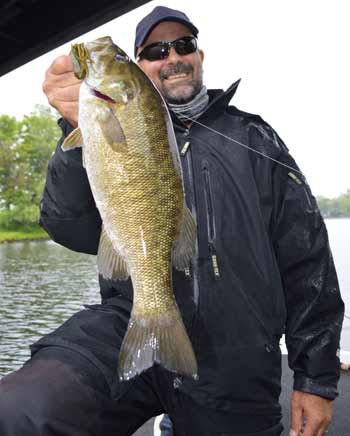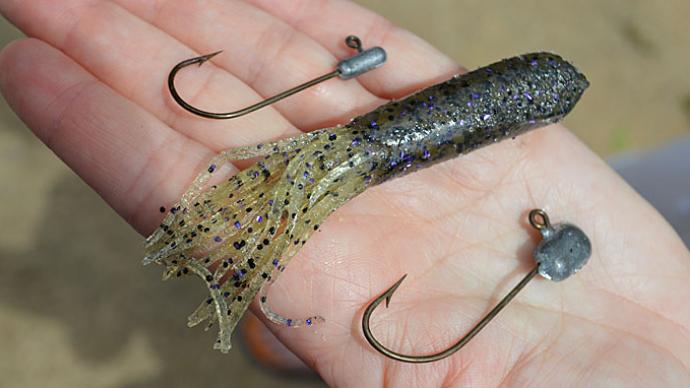
Bobby Garland didn’t know the bass-catching power he unleashed when he invented the Gitzit more than 50 years ago. The Utah-based angler wanted a better way to catch Western bass, most of which swim in crystal clear water. When word about his tube jig went east, thanks to some tournament pairings, including with legendary Guido Hibdon, bass anglers everywhere benefited from his creation.
But times have changed. The once-hot tube jig has cooled in the eyes of many bass anglers. Newer finesse techniques, especially drop shots for catching smallmouth, have taken much of its thunder. But in the right hands, they still catch more than their fair share of largemouth, smallmouth, and spotted bass.
Tubes aren’t a one-trick pony. They work year-round anywhere bass are found: Some anglers jig them through the ice. Bigger versions measuring 5 inches or longer are popular for flipping and pitching when Texas rigged. And an alternate rigging method — the Stupid Tube — mixes snagless Texas rigging with an internal weight. It’s perfect for dragging through cover such as laydowns and brush.
While larger versions and alternate riggings make tubes productive in more situations, it’s hard to beat the original. No longer than your finger, exposed hook, and internal weight, these tube jigs keep catching bass wherever there’s a hard bottom and no more than sparse aquatic vegetation or brush.
That combination creates a lure that randomly dips and dives when it's hopped or hunts when dragged along the bottom. Fishing tube jigs on the correct setup intensify their action, helping you catch more and bigger bass. Here’s how to pull it together.
Rod
If you flip or drag a tube into or through cover, you’ll want baitcasting gear, which easily handles heavy lines and big battles. But that won’t help a traditionally rigged tube jig. The most finesse version needs a subtle presentation. And that’s best created with a spinning rod.
Your spinning rod should have a fast action — only flexing in the first few inches of its tip. That crisp feel casts light-weight lures farther and with more accuracy. Match that action to medium power, and you’ll solidly set the thin wire hook found in most tube jig heads. That’s because the power you put into the rod quickly transfers to its backbone.

Long spinning rods work best for tube jigs. Choose one that’s between 7 and 7 1/2 feet. Its extra length acts as a cushion, protecting the light line from a bass’s sudden surges and jumps, both of which can snap it instantly.
Reel
The reel is the least important part of your tube-jig setup. It spends most of its time simply collecting slack line after each move of your lure. So, don’t worry about its gear ratio. Focus on its spool instead.
While 2000 and 2500 size spinning reels are most popular with bass anglers, step up to the next size. Its spool’s diameter will be slightly larger. That helps casting distance because the line more freely flows off the spool. It also eliminates most tangles by storing line in larger loops, reducing memory.
Keep track of a few other characteristics when choosing a spinning reel. More ball bearings, for example, keep a reel turning smoothly and lasting longer. And a front drag, which has large washers, releases with less force. That is vital when fighting big smallmouth or spotted bass.
Line
Monofilament and fluorocarbon lines have their positive attributes. But braided line’s sensitivity and lack of memory make it best for tube jigs. Even though it packs plenty of strength in a small diameter — 30-pound test braided line, for example, is nearly the diameter of 8-pound test monofilament — it pays to go light, 10-pound test or less. It casts better and allows tube jigs, mainly lightly weighted, to produce more action.
The downside of braided line is its visibility underwater, even though many bass anglers swear it doesn’t make a difference. If you’re fishing clear water — where most traditional tube jigs are deployed — and concerned bass are spooked by your line, there are a couple of things that you can do. The easiest is using a permanent marker to add black or green splotches throughout the first few feet of line in front of your lure. Those will break its silhouette.
Your other option is tying in a monofilament or fluorocarbon leader. Be sure to use a pound test similar to your braided line. FG and Alberto are the two most popular knots for attaching a leader. Properly tied, both will freely make their way through your rod’s line guides without being damaged. So, start with a leader as long as your spinning rod. That will allow you to retie several times after losing tube jigs to snags.
Lead head
Garland’s original Gitzit was lightly weighted. It spiraled and darted in a different direction each time it sank. An internal weight was vital to creating that action.

Tubes can be rigged on various lead heads, including the basic ball. Rigged like a grub, with the lead head outside the lure, it will make predictable drops and rises as it comes straight back to you. But insert that same head, popping its line tie through the plastic an 1/8 or 1/4 inch from the tube’s front, and you’ll create an erratic action that bass can’t resist. It can be improved by matching the shape of the jig head to how you’re fishing.
Make your tube swim erratically while jigging it back to the boat using a flat lead head. Stick to lightweight ones — no more than 3/16 ounce. That will slow your lure’s fall, giving it more time to dip and dive.
Tube jigs are just as productive when dragged across the bottom, where they imitate a crawfish or the invasive goby, which is the latest menu addition for Great Lakes smallmouth. That requires a heavy head — as much or more than 3/8 or 1/2 ounce. The head you choose also needs to be round, so it rocks your tube forward or to the side when it catches on the bottom. Cylindrical heads are best because they also disperse the added weight down the hook shank, making it easier to stuff inside a tube.
Some heads concentrate most of their mass at the front and then quickly taper toward the hook’s bend, giving tubes a goby-like profile. That may create a few more bites if you’re fishing the Great Lakes. But like the lighter-weight ones used for jigging, ensure all lead heads you use inside your tubes sport a thin-wire hook.
Once you pick the perfect lead head for how you’re fishing, don’t be too quick to insert it and start fishing. Make it better with some sound.

Bass are curious creatures. They’re attracted to many things, including sound. It’s proven that a lure banging off cover or filled with rattles can attract more bass than silent ones in certain situations. While some tube jig heads are sold with rattles molded into them, more aren’t. But it’s easy to add your own.
You can find rattles that clip on a hook shank. But if you have a bag of glass rattles, which are louder than plastic ones, designed to be inserted into soft-plastic lures, such as worms or craws, you already are well on your way. Hold one parallel with the hook shank, directly behind the lead. Make a couple of dozen wraps with fly-tying thread — the thicker, the better — then tie off the ends with a simple overhand knot. Secure them with a swipe or two of head cement or a couple of drops of super glue. That’ll keep the rattle in place, making it easy to insert the whole apparatus into a tube.
Tube
From monster-sized ones built for musky to tiny temptations that panfish can inhale, soft-plastic tubes come in a wide spectrum of sizes. But when chasing bass, it’s best to go for the middle — 3 1/4 to 4 inches long.
Tubes in this range better match the crawfish and baitfish — shad, young perch, and others — that bass chase. They also match well to an internal jig head. Longer tubes, for example, outstretch the hook’s shank, making rigging more difficult and missed strikes more likely. Ideally, the hook should bend where the tube’s body and tails meet. That also puts the line tie in the perfect place, though backing it up will squeeze more action out of some tubes.
Tube jigs are most productive in clear to stained water. So, natural hues, shifting darker as the water takes on more color, work best. Watermelon, for example, is an excellent choice in clear water. But go with the opaque green pumpkin in stained water. Its contrast against its surroundings makes it easier for bass to find.
Most tubes are ready to roll straight from the package. But before you rig one, make sure its tails are completely cut. Sometimes they can still be attached at the end, which kills their action. A few small snips with scissors will release them.
BassResource may receive a portion of revenues if you make a purchase using a link above.




